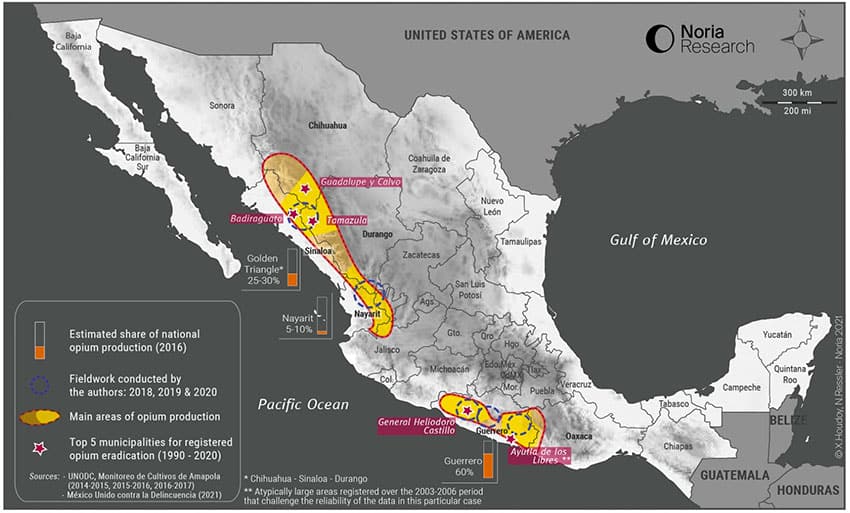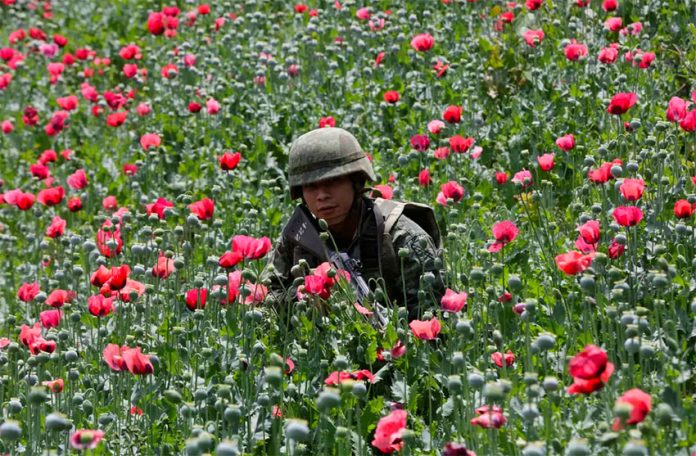There are 59 main opium poppy-growing municipalities across six states, according to a new project that mapped production of the illicit crop in Mexico, one of the world’s largest heroin producers.
Produced by Noria Research in alliance with Mexico United Against Crime, the Center for U.S.-Mexican Studies at the University of California, San Diego, and the magazine Espejo, the Mexico Opium Project determined through data analysis that the efforts of the National Defense Ministry to eradicate poppies between 2003 and 2019 were concentrated in 59 municipalities in three large regions.
Twenty-nine are located in the northwestern region that includes parts of the states of Chihuahua, Sinaloa, Durango and Nayarit.
Among the municipalities are Ocampo and Guadalupe y Calvo in Chihuahua, Culiacán and Badiraguato – the municipality where convicted drug lord Joaquín “El Chapo” Guzmán was born – in Sinaloa, Canelas and Topia in Durango and La Yesca and Compostela in Nayarit.
Twenty-three of the municipalities are located in the southwestern region, which encompasses a group of Guerrero municipalities and two in Oaxaca. Among them are Eduardo Neri, Leonardo Bravo, Chilapa and Chilpancingo in Guerrero and Coicoyán de las Flores and San Martín Peras in Oaxaca.
The third region, with seven poppy-growing municipalities, is located in Oaxaca. Its municipalities are Miahuatlán de Porfirio Díaz, Villa Sola de Vega, San Carlos Yautepec, San Juan Lachigalla, San Pedro Quiatoni, Santa María Tepantali and Santiago Xanica.
The report said the mountainous geography of the three regions is similar, with elevations of up to 3,400 meters in the southern and southwestern regions and up to 3,200 meters above sea level in the northwestern region.
It said that on average one hectare of opium poppies was recorded as destroyed in the 59 municipalities for every 38 hectares of legal crops planted between 2003 and 2019.
Presented on Wednesday, a section of the report entitled Why is opium production crucial to better understand the War on Drugs in Mexico? noted that poppies have been cultivated in the Golden Triangle region of Chihuahua, Sinaloa and Durango for over 60 years and for almost 40 years in Guerrero.
“This activity is deeply integrated into society. In poppy-growing territories, between 70% and 95% of the population – men, women, and children – work in, or earn their living through, activities directly or indirectly related to opium,” it said.
The report, which is also based on 15 months of fieldwork in opium-producing states, also said that the army reported destroying poppies in 835 of Mexico’s 2,465 municipalities between 2003 and 2019. That means that poppies have been grown in at least one-third of the nation’s municipalities.

“The U.S. government affirms that in 2016 Mexico had 32,000 hectares of opium production, which increased to 44,100 in 2017,” the report said.
In a “key facts” section, the report also said that heroin produced in Mexico is exported almost in its entirety to the United States and Canada, where it represents around 90% of the consumption market.
While opium gum prices plummeted in recent years partially due to the rise in popularity of the synthetic opioid fentanyl, prices recovered in mid-2020, the report said. The Mexico Opium Project estimated that growers are currently paid up to 21,000 pesos (about US $1,000) for a kilogram of opium paste.
The report said “illicit economies constitute one route for escaping from a subaltern position in a context of chronic economic and social crises in the Mexican countryside.”
However, “in the productive chain of heroin, much of the money generated is captured by legal and illegal intermediaries. This means that the fantastic profitability of the final product has an almost null structural impact on inequalities, discrimination, criminalization, or the lack of state investment.”
Many poppy growers say they are forced to cultivate the crop due to a lack of other opportunities and government support. Farmers in Guerrero have appealed to López Obrador to legalize the cultivation of opium poppies for use in the manufacture of legal pharmaceuticals.
The president indicated earlier this week that the government is prepared to consider legalization of the crop for that purpose.
“With regard to the commercialization of marijuana and poppies, the decision has been taken to initiate a thorough analysis of these crops considering that [the growers] are being left behind and they’re being used for the production of [illicit] drugs,” he said.
Interior Minister Olga Sánchez, who said before the current government took office that López Obrador had given her a “blank check” to explore the possibility of legalizing drugs as well as any other measures that could help restore peace to the country, said in January that legalization of poppy production for medicinal purposes was possible.
“This opiate could be regulated by legislation so that we can obtain all kinds of medicines,” she said.
Guerrero Governor Héctor Astudillo supports legalization of poppy production, which he says could help to reduce violent crime, but an initiative to that end has stalled in the state Congress.
Mexico News Daily
